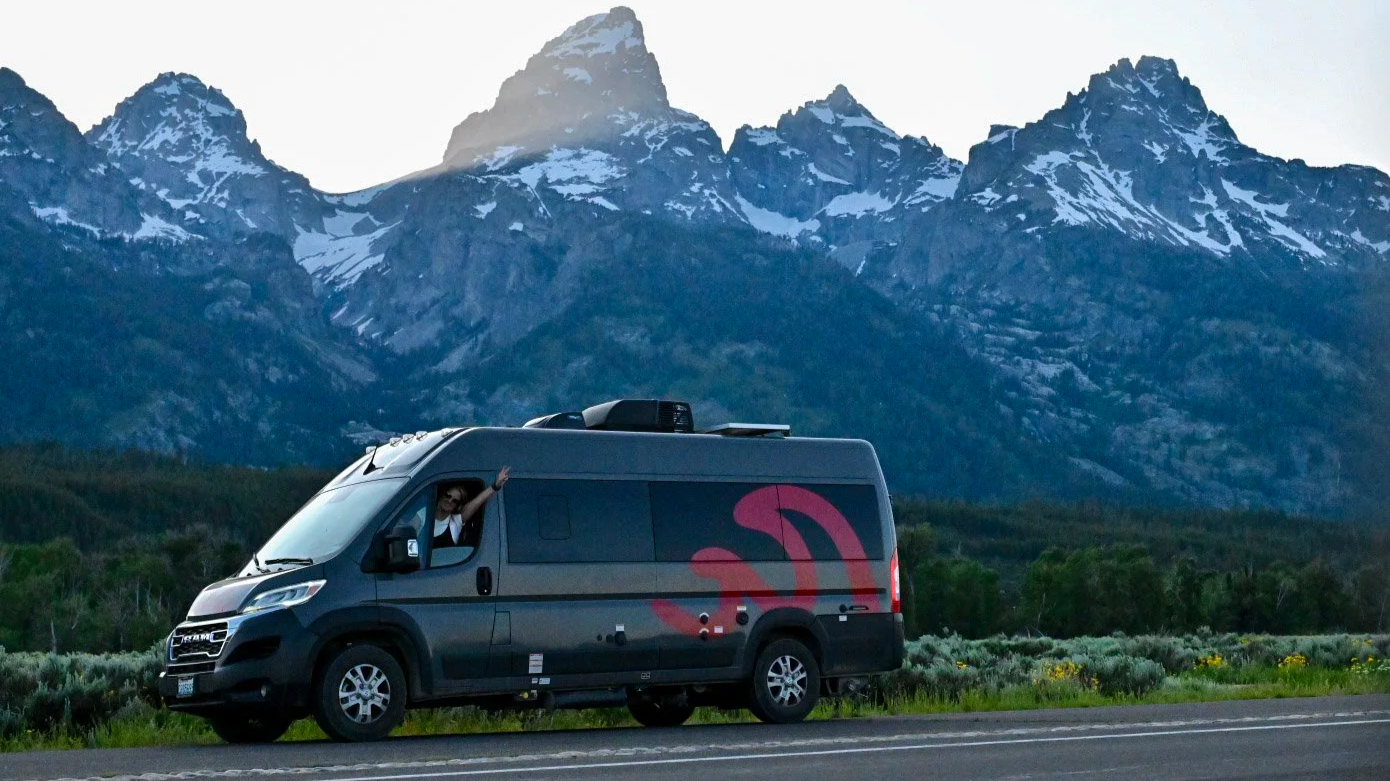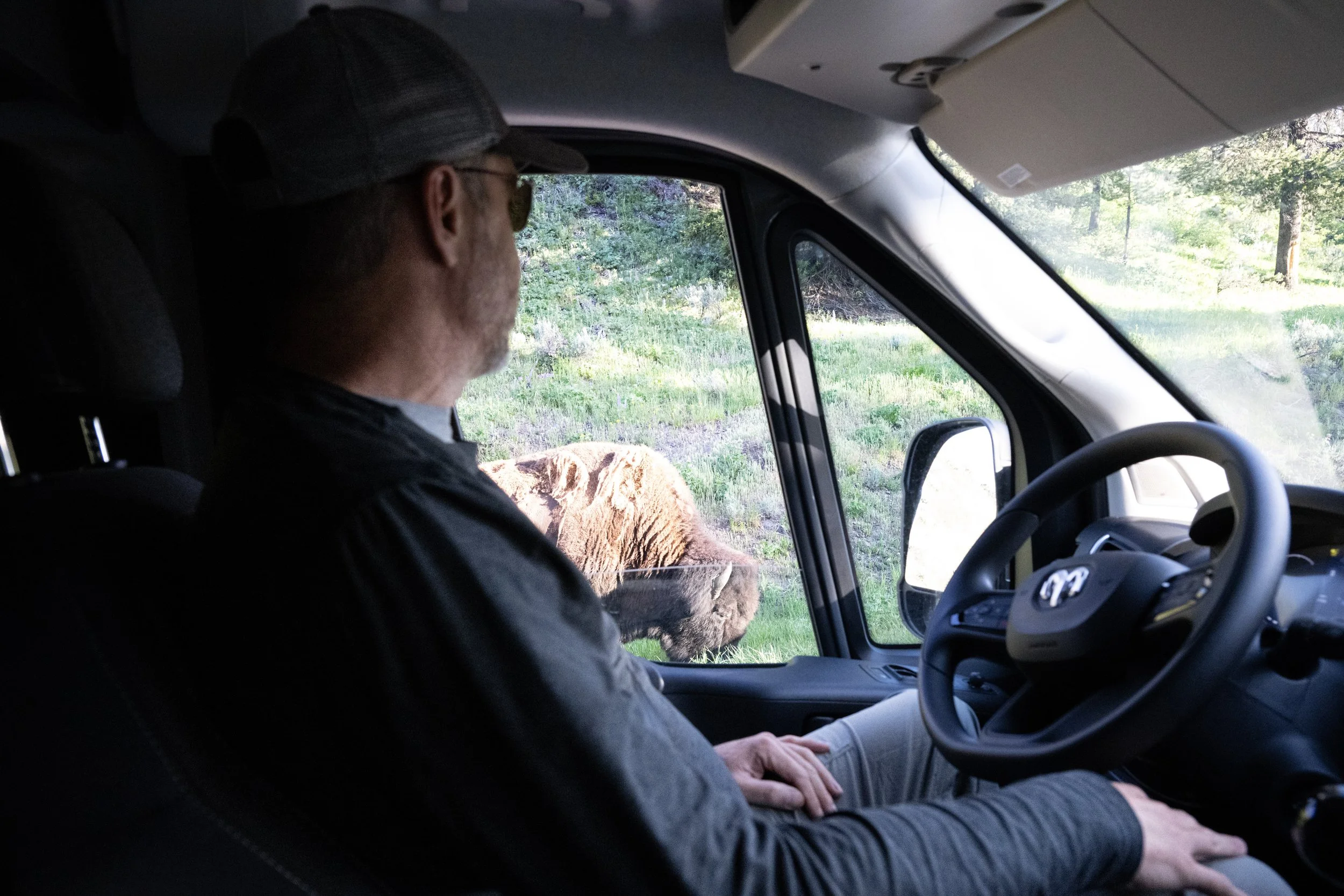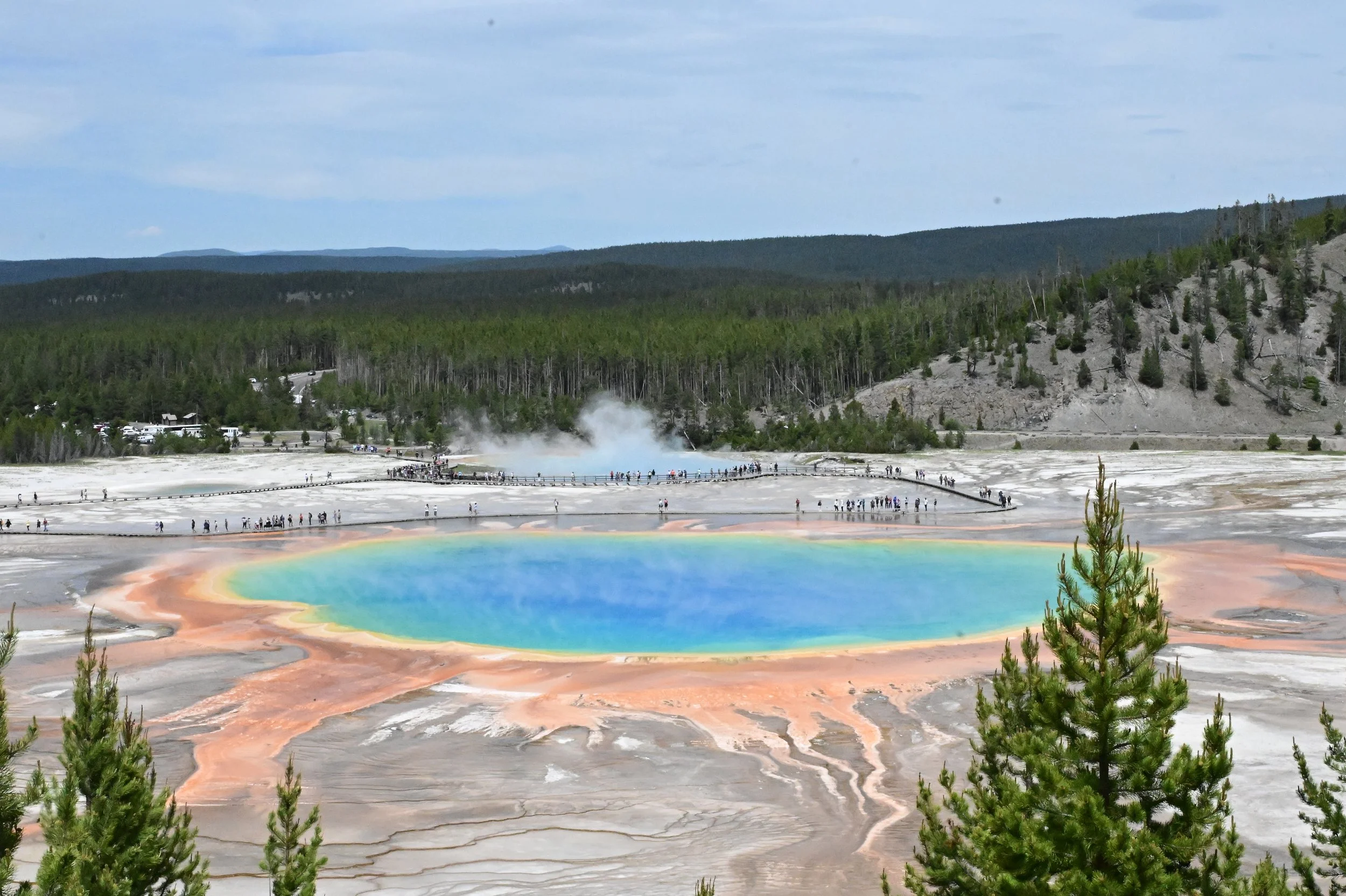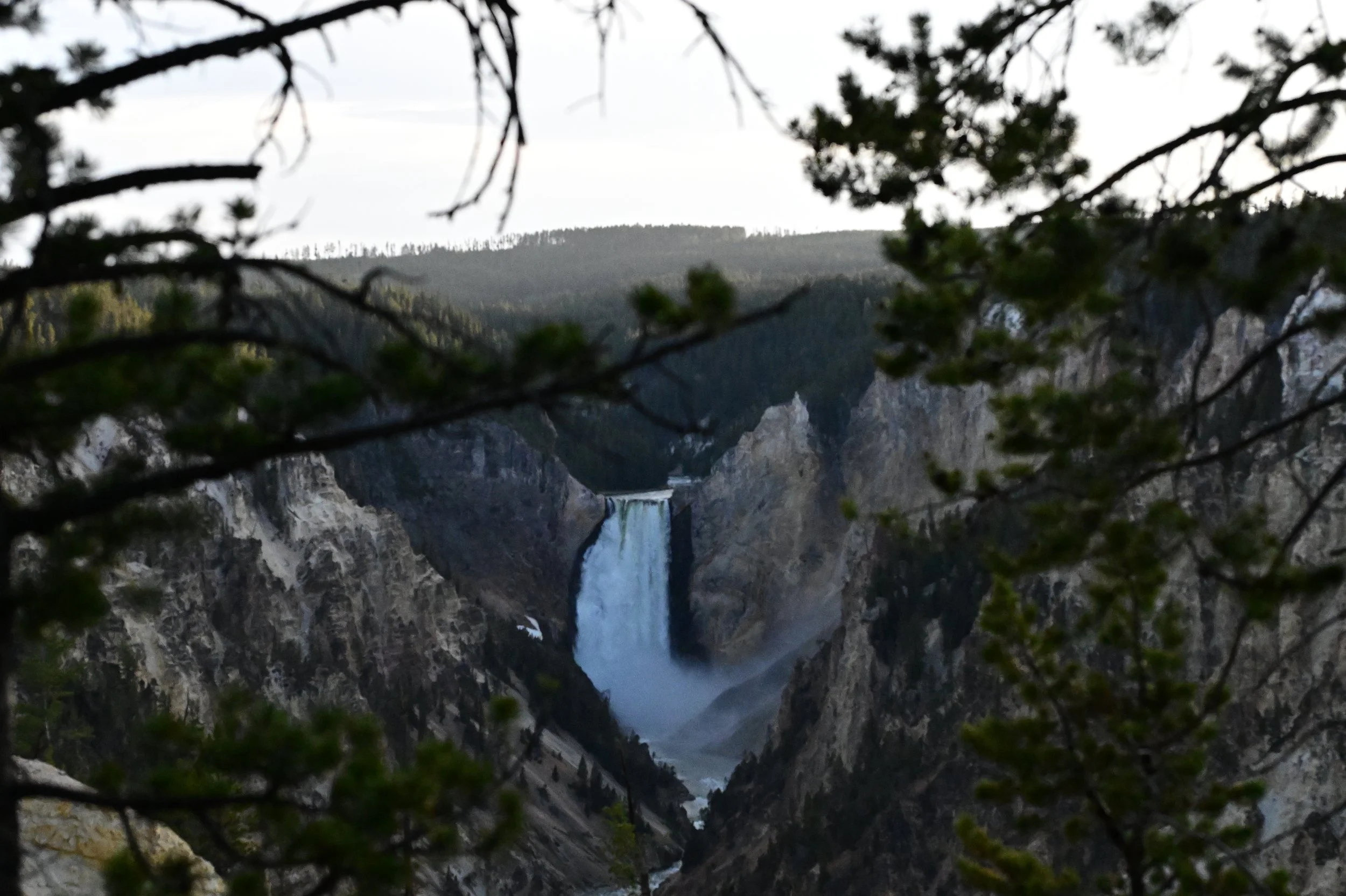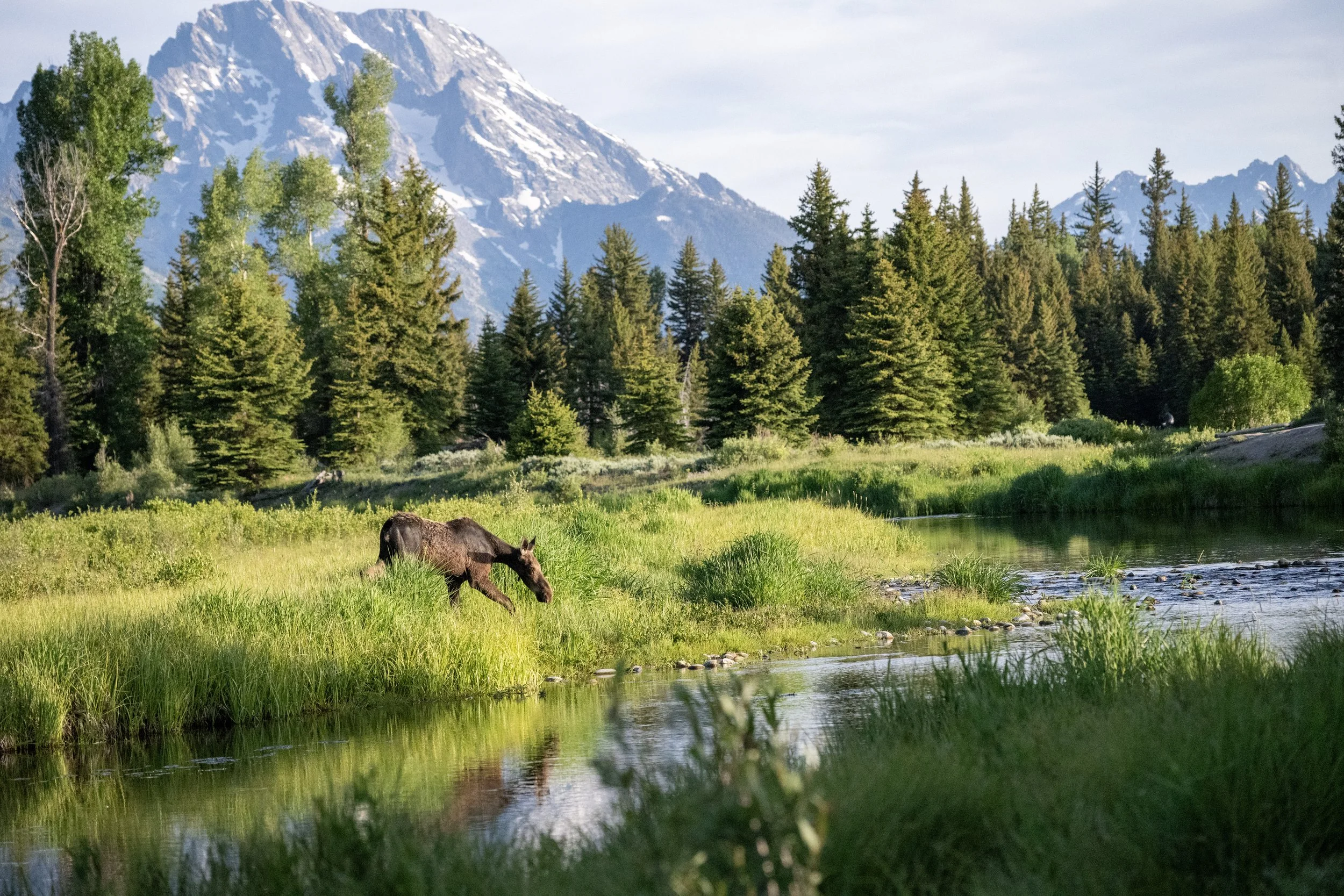Our First Campervan Adventure: 9 Days in Yellowstone & Grand Teton National Parks
Grand Teton National Park
Four Wheels, Two Parks, One Unforgettable Adventure
After years of hiking trails, logging miles on road trips, and chasing every mountain view we could find, we finally took the plunge into campervan life. And honestly? There was no better stage than two of America’s most legendary landscapes: Yellowstone National Park and Grand Teton National Park.
Thanks to our friends at roadsurfer, who partnered with us for this adventure and set us up with a sweet home on wheels, we had the freedom to roam at our own pace, pulling over for wildlife sightings, brewing coffee wherever the mood struck, and waking up with mountain peaks outside our windows.
Spoiler alert: you had me at Yellow…
Day 1 – Touchdown in Salt Lake City, Utah
The roadsurfer team? Incredible. They not only walked us through every detail of the van (essential for first-timers) but did it with a sense of humor that instantly put us at ease. They even slipped us some bear spray left behind by another traveler. Practical and thoughtful.
Picking up our campervan in Salt Lake City, Utah
Before heading north, we stocked up on groceries. A trip goal was to cook nearly all our meals in the van—breakfasts, trail snacks, dinners, everything. It saved money, kept us fueled, and cooking in the compact kitchen became one of our favorite rituals. (Yes, tacos were on repeat.)
Day 2 – Wind River Country Stopover
Leaving Salt Lake behind, we made our first overnight stop at Fremont Lake Campground near Pinedale, Wyoming. The drive is about 250 miles (roughly 4.5–5 hours), crossing open Wyoming landscapes before the jagged profile of the Wind River Range comes into view.
At nearly 12 miles long and 600 feet deep, Fremont Lake is the state’s second-largest natural lake, carved by glaciers from the Wind River Mountains. The campground sits right along the shoreline, with quiet forested sites and wide-open views of the water.
Nestled at the base of the Wind River Range, home to more than 40 named peaks over 13,000 feet, this peaceful lakeside spot was the perfect place to unwind, stargaze, and test out our van kitchen for the first time. Pinedale itself has deep ties to the region’s history, once serving as a gathering place for fur trappers and mountain men in the 1800s.
🌮 Meal highlight: tacos, round one.
Dinner at Fremont Lake Campground, Wyoming
Day 3 – Hiking the Green River Lakes Loop
Remote, rugged, and breathtaking, the Green River Lakes Loop (7.7 miles) was one of the most scenic hikes of the trip. To get there, we tackled an 18-mile unpaved road: slow-going in a campervan, but worth every bump.
The trail begins at the headwaters of the Green River, which eventually flows 730 miles through Wyoming, Utah, and Colorado before joining the Colorado River. With Square Top Mountain dominating the skyline and two turquoise lakes reflecting the peaks, the setting felt almost untouched.
Despite its grandeur, the trail was remarkably quiet. After the first mile, it was just us, the sound of the river, and pure mountain silence. The broader Wind River region is also home to the Wind River Indian Reservation, where the Eastern Shoshone and Northern Arapaho tribes live today, adding a rich cultural layer to this already storied landscape.
📍 Trail Info: Green River Lakes Loop on AllTrails
Green River Lakes Loop
Days 4–6 – Yellowstone National Park
Roosevelt Arch at Yellowstone National Park
Next up: Yellowstone National Park, a place that feels more like another planet than anywhere else we’ve visited. Spanning over 2.2 million acres, larger than Rhode Island and Delaware combined and spanning over Wyoming, Montana and Idaho. Yellowstone is America’s first national park and still one of its most unique. We spent three nights here, splitting our stay between Canyon Campground and Madison Campground, which gave us a good home base to explore different corners of the park.
Canyon Campground at Yellowstone National Park
One of the best parts of traveling by campervan was the flexibility it gave us. Whether pulling over for a roadside picnic, brewing a mid-morning coffee, or simply waiting as a herd of bison decided the highway belonged to them.
View of bison out of window.
Geysers, Hot Springs & Geothermal Wonders
No trip to Yellowstone is complete without standing in the mist of Old Faithful, but what surprised us most were the otherworldly geothermal features scattered across the park. Yellowstone is home to over half of the world’s geysers, along with countless hot springs, mudpots, and fumaroles. A few highlights:
Grand Prismatic Spring: so vibrant it looks unreal, especially from the overlook trail that lets you take in the full spectrum of color. (Best time to take a photo is mid-afternoon when sun is overhead.)
Morning Glory Pool: a rainbow-colored spring whose hues shift with the heat-loving bacteria that thrive in its water.
Mammoth Hot Springs: cascading travertine terraces that look like they belong in a sci-fi landscape.
Old Faithful
Grand Prismatic Spring
Morning Glory Pool
West Thumb Geiser Basin
Mammoth Hot Springs
The Grand Canyon of the Yellowstone
We didn’t have much time here, just about 30 minutes late in the evening but even in that short window, the view was unforgettable. From Artist Point, we looked down at the Yellowstone River slicing through golden cliffs with Lower Falls thundering in the distance. The light was soft, the crowds had thinned, and it felt like we had the canyon to ourselves. Proof that even a quick stop at this spot is worth it.
Grand Canyon of the Yellowstone
Side Drive: Beartooth Scenic Byway
Often called one of America’s most beautiful drives, the Beartooth Highway stretches for 68 miles between Red Lodge, Montana, and Cooke City, Wyoming, climbing to 10,947 feet at Beartooth Pass. The route winds through Custer, Shoshone, and Gallatin National Forests, offering sweeping alpine views, glacial lakes, and tundra that looks more like Alaska than the lower 48. Even in June, we passed towering snowbanks and icy lakes just beginning to thaw.
The road is typically only open from late May through mid-October, depending on weather conditions, and sudden summer snowstorms are not uncommon. Always check road status before heading out. Our timing was lucky, as it had reopened just in time for our trip. With dozens of pull-offs, switchbacks, and panoramic overlooks, it’s the kind of drive where you’ll want to take your time.
Side Trip: Mesa Falls, Idaho
From West Yellowstone, we detoured into Idaho to see Mesa Falls, a gem of the Caribou-Targhee National Forest. The Upper Falls plunges 114 feet over a basalt cliff formed by ancient volcanic activity, while the Lower Falls drops another 65 feet downstream. Both are accessible via short walks, with boardwalks and overlooks that get you up close to the roaring water. On sunny days, rainbows often appear in the mist, adding even more magic to the scene.
The best time to visit is in the morning when the light hits the water just right, but it’s worth a stop at any time of day. (For reference, our photo below was taken at 2 p.m.) Mesa Falls made for a perfect half-day adventure and a nice change of scenery from the geysers and peaks we had been exploring.
Mesa Falls, Idaho
Dining Out (Just Once)
We cooked nearly every meal in the van, except one. In West Yellowstone, we tried Firehole BBQ, a rustic spot with meats smoked low and slow. We arrived at 4 p.m., waited 20 minutes, and by the time we sat down, the line stretched out the door. Worth it.
Dinner at Firehole BBQ
Days 7–8 – Grand Teton National Park
The final stretch brought us to Grand Teton National Park, where we camped at both Gros Ventre Campground, one of the largest in the park and often home to grazing moose, and Colter Bay Campground, set near Jackson Lake with easy access to trails and boat rentals.
Lake near Colter Bay Campground
The Tetons rise abruptly from the valley floor with no foothills to soften the view, creating one of the most dramatic mountain skylines in North America. The range includes over a dozen peaks above 12,000 feet, with the Grand Teton itself reaching 13,775 feet.
Evening at Grand Teton Park Sign
Photo Stops: Schwabacher Landing & Oxbow Bend
Before setting out on the Delta Lake Trail, we made time for two of Grand Teton’s most photogenic roadside spots: Schwabacher Landing and Oxbow Bend.
Schwabacher Landing was the easiest place in the park to photograph. Flat access, wide river views, and those classic mountain reflections. We missed the famous sunrise glow on the peaks, but the scene was still worth it. Best of all, we spotted moose grazing nearby, which quickly made this stop a highlight.
Moose grazes at Schwabacher Landing
Oxbow Bend offered a different but equally iconic view: the Snake River curving with Mount Moran rising behind it. It’s a simple pull-off with plenty of space to set up a camera and capture that postcard-perfect shot.
Early morning at Oxbow Bend
Oxbow Bend
Both of these spots are easy to reach and deliver big rewards with minimal effort, making them perfect detours if you’re on your way to longer hikes.
📍 Pro tip: If you’re after the “money shot,” sunrise is best for both locations, but even later in the day you’ll walk away with frame-worthy photos. And June is a haven for flowers. They were everywhere we looked.
Delta Lake Trail
Delta Lake quickly became one of the most unforgettable hikes of our trip. This strenuous 7.4-mile trek with more than 2,200 feet of elevation gain is not an official maintained trail, which means the climb is a bit of a challenge. Think steep switchbacks, boulder scrambles, and loose gravel that will test your legs and balance.
But every step was worth it. After pushing through the last steep stretch, the forest suddenly opened to reveal Delta Lake, an unbelievable turquoise alpine lake tucked beneath the dramatic spires of the Grand Teton. The contrast of the glacial water against the rugged peaks felt like stumbling into a hidden world. We lingered here for a while, soaking it all in, eating a snack, and just staring at the scenery.
Be prepared: this is a tough hike, and the route can be confusing at times. Solid footwear, plenty of water, and trekking poles go a long way. It’s also one of the most popular “hidden gem” hikes in the park, so starting early helps you avoid crowds and find a quiet moment at the lake.
Delta Lake, Grand Teton National Park
Cascade Canyon Trail via Jenny Lake
If there’s one hike that sums up why Grand Teton is so unforgettable, it’s Cascade Canyon. We started at String Lake, looped around the edge of Jenny Lake, and then climbed past Hidden Falls and Inspiration Point, already a solid list of highlights before the real show began.
Once we entered Cascade Canyon, the trail leveled out into a broad valley carved by glaciers, with granite cliffs rising on either side and the jagged Teton peaks towering in the distance.
But the real story? Wildlife. Over the course of the hike we saw five bears, including a mama with two cubs. Watching them from a safe distance was pretty awesome. Between the bears, moose, marmots, and countless birds, this trail felt alive in a way no other hike on the trip did.
Jenny Lake itself also deserves its own mention: glassy, turquoise, and perfectly still in the early morning. Many hikers take the shuttle boat across to save mileage, but walking the shoreline gave us time to soak it all in and avoid crowds.
Day 9 – Back to Salt Lake City
After more than a week on the road, we eased back into city life with an overnight in Salt Lake City before returning our roadsurfer van. We grabbed coffee at Loki Coffee, savored sushi at Kyoto Japanese Restaurant, and played tourist for a few hours, hitting some of the city’s most popular spots.
The next morning came the bittersweet part: handing back the keys to our campervan. In just nine days, we’d gone from wide-eyed first-timers to full-fledged vanlife fans, and it was hard to let go of the little rolling home that had carried us through mountains, valleys, and national park magic.
Campervan Travel Tips for National Parks
Skip the suitcase → Pack soft duffels & cubes.
Meal prep ahead → The van kitchen is your best friend.
Stay flexible → Weather and wildlife don’t keep schedules.
Stay organized → Use bins for daily essentials.
Manage your water → Know refill and dump stations.
Pack layers → Mountain temps swing fast.
Download offline maps → Cell service is spotty at best.
Final Thoughts
Our roadsurfer campervan wasn’t just transportation, it was part of the adventure. From sipping morning coffee while bison grazed outside to cooking dinner with mountain views to stargazing after long hikes, vanlife gave us freedom, flexibility, and front-row seats to some of the most beautiful landscapes in the American West.
We’re already dreaming of the next trip. Be sure to follow me on Instagram to see where we are!
Practical Info: Planning Your Own Campervan Trip
Route Overview
Home Base: West Virginia
Start/End: Salt Lake City, Utah
Main Stops: Wind River Range → Yellowstone National Park → Grand Teton National Park → Salt Lake City
Total Days: 9
Approximate Driving Distance: ~1,200 miles
Campgrounds We Stayed At
Fremont Lake Campground (Pinedale, WY)
Canyon Campground (Yellowstone)
Madison Campground (Yellowstone)
Gros Ventre Campground (Grand Teton)
Colter Bay Campground (Grand Teton)
Roadsurfer Campervan Highlights
Kitchen with fridge, stove, and sink
Shower & toilet
Convertible sleeping area
Easy to drive and park
Budget Tips
Cook in the van: groceries for 9 days saved us hundreds vs. eating out.
National Park Pass: Get the America the Beautiful Pass ($80/year) It paid for itself on this trip.
Campgrounds: Book early if traveling in peak season (summer/fall).
When to Go
Late spring through early fall offers the best mix of open roads, mild temps, and accessible trails.
Expect chilly mornings and possible snow at higher elevations, even in June.
Campervan Rental:
We highly recommend roadsurfer and will definitely use them again!
